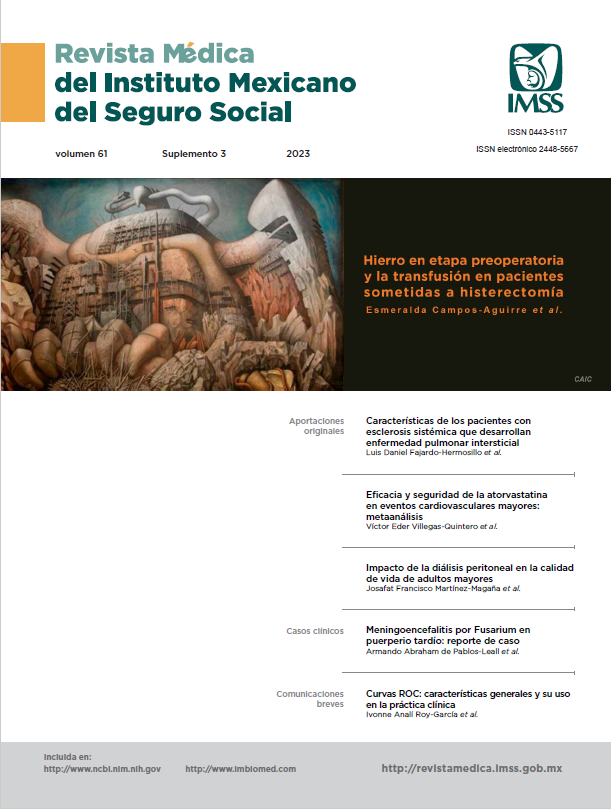Iron in pre-operative stage and transfusion in patients undergoing hysterectomy
Main Article Content
Keywords
Iron, Blood Transfusion, Myoma
Abstract
Background: The correction of preoperative anemia is part of the patient blood management program, in order to improve the patient’s clinical results by reducing the number of transfusions in surgery. Uterine fibroids can cause anemia, so the application of iron before hysterectomy could reduce transfusion.
Objective: To evaluate the impact of iron treatment in the preoperative stage on the need for transfusion in patients with anemia secondary to myomatosis in the trans and postoperative stage of hysterectomy.
Material and methods: Patients with uterine myomatosis who presented with microcytic anemia in the preoperative stage were included; clinical records were reviewed, the clinical characteristics of the population were obtained; The patients were distributed into two study groups according to whether or not they had received iron treatment; the outcome variable was the transfusion of packed erythrocytes in the first 7 days after surgery.
Results: 134 patients were included, with a median fibroid size of 4 cm. 21 (15.6%) patients used iron. Patients who used iron had a relative risk (RR): 0.36 (95%CI: 0.12-1.07). Delta hemoglobin < 1 g/dL, RR: 1.59 (95%CI: 0.94-2.67). Uterine fibroid size > 5cm had a RR of 1.96 (95%CI: 1.25-3.05).
Conclusion: Treatment with iron in the pre-surgical stage showed a tendency to protect transfusions in the trans and post-surgical stage. The main factor related to transfusion was fibroid size > 5 cm.
References
Gofur N, Myoma U. Uterine Myoma, Risk Factor and Pathophysiology: A Review Article. Clin Onco. 2021;4(3):1-4.
Giuliani E, As-Sanie S, Marsh EE. Epidemiology and management of uterine fibroids. International Journal of Gynecology and Obstetrics. 2020;149(1):3-9. doi:10.1002/ijgo.13102
Fowler AJ, Ahmad T, Phull MK, Allard S, Gillies MA, Pearse RM. Meta-analysis of the association between preoperative anaemia and mortality after surgery. Br J Surg. 2015;102(11):1314-1324. doi:10.1002/bjs.9861
Smilowitz NR, Oberweis BS, Nukala S, et al. Association Between Anemia, Bleeding, and Transfusion with Long-term Mortality Following Noncardiac Surgery. Am J Med. 2016;129(3):315-23.e2. doi:10.1016/j.amjmed.2015.10.012
Rössler J, Schoenrath F, Seifert B, et al. Iron deficiency is associated with higher mortality in patients undergoing cardiac surgery: a prospective study. Br J Anaesth. 2020;124(1):25-34. doi:10.1016/j.bja.2019.09.016
Pasricha SR, Tye-Din J, Muckenthaler MU, Swinkels DW. Iron deficiency. The Lancet. 2021;397(10270):233-248. doi:10.1016/S0140-6736(20)32594-0
Goodnough LT, Maniatis A, Earnshaw P, et al. Detection, evaluation, and management of preoperative anaemia in the elective orthopaedic surgical patient: NATA guidelines. Br J Anaesth. 2011;106(1):13-22. doi:10.1093/bja/aeq361
Sullivan HC, Roback JD. The pillars of patient blood management: key to successful implementation (Article, p. 2840). Transfusion (Paris). 2019;59(9):2763-2767. doi:10.1111/trf.15464
Ripollés-Melchor J, Jericó-Alba C, Quintana-Díaz M, García-Erce JA. From blood saving programs to patient blood management and beyond. Med Clin (Barc). 2018;151(9):368-373. doi:10.1016/j.medcli.2018.02.027
Swift A, Lucero H, Hamilton C, Carroll C. Strategies to avoid intraoperative blood transfusion. Anaesthesia & Intensive Care Medicine. 2019;20(3):142-146. doi:https://doi.org/10.1016/j.mpaic.2019.01.023
Isbister JP. The three-pillar matrix of patient blood management--an overview. Best Pract Res Clin Anaesthesiol. 2013;27(1):69-84. doi:10.1016/j.bpa.2013.02.002
Rössler J, Schoenrath F, Seifert B, et al. Improving preoperative haemoglobin using a quality improvement approach to treat iron deficiency anaemia. Br J Anaesth. 2020;124(1):25-34. doi:10.1136/bmjoq-2019-000776
Revel-Vilk S, Naamad M. Patient blood management programs: How to spread the word? Isr J Health Policy Res. 2018;7(1). doi:10.1186/s13584-018-0204-5
Lethaby A, Puscasiu L, Vollenhoven B. Preoperative medical therapy before surgery for uterine fibroids. Cochrane Database of Systematic Reviews. 2017;2017(11). doi:10.1002/14651858.CD000547.pub2
Meybohm P, Froessler B, Goodnough LT, et al. “Simplified International Recommendations for the Implementation of Patient Blood Management” (SIR4PBM). Perioperative Medicine. 2017;6(1). doi:10.1186/s13741-017-0061-8
Morales HSG, López RR, López GGP, et al. Surgical approach to uterine myomatosis in patients with infertility: open, laparoscopic, and robotic surgery; results according to the quantity of fibroids. J Bras Reprod Assist. 2022;26(1):44-49. doi:10.5935/1518-0557.20210049
Gómez-Ramírez S, Bisbe E, Shander A, Spahn DR, Muñoz M. Management of Perioperative Iron Deficiency Anemia. Acta Haematol. 2019;142(1):21-29. doi:10.1159/000496965
Mansour D, Hofmann A, Gemzell-Danielsson K. A Review of Clinical Guidelines on the Management of Iron Deficiency and Iron-Deficiency Anemia in Women with Heavy Menstrual Bleeding. Adv Ther. 2021;38(1):201-225. doi:10.1007/s12325-020-01564-y
Beverina I, Razionale G, Ranzini M, Aloni A, Finazzi S, Brando B. Early intravenous iron administration in the Emergency Department reduces red blood cell unit transfusion, hospitalisation, re-transfusion, length of stay and costs. Blood Transfusion. 2020;18(2):106-116. doi:10.2450/2019.0248-19
Ramos JG, Zeller MP. Evidence-Based Minireview: The Role of IV Iron in Management of Patients with Iron-Deficiency Anemia Presenting to the Emergency Department. www.gradeworkinggroup.org
Laberge PY, Murji A, Vilos GA, Allaire C, Leyland N, Singh S (Sony). Guideline No. 389-Medical Management of Symptomatic Uterine Leiomyomas – An Addendum. Journal of Obstetrics and Gynaecology Canada. 2019;41(10):1521-1524. doi:10.1016/j.jogc.2019.01.010
Richards T, Musallam KM, Nassif J, et al. Impact of preoperative anaemia and blood transfusion on postoperative outcomes in gynaecological surgery. PLoS One. 2015;10(7). doi:10.1371/journal.pone.0130861
Akbari E, Sarbazi F, Karimi A, Nouri B, Ardebili SN. Comparison of Laparoscopic Myomectomy Outcomes Based on Myoma Weight: A Cross-sectional Study. International Journal of Women’s Health and Reproduction Sciences. 2022;10(1):16-18. doi:10.15296/ijwhr.2022.04
Manejo hemático del paciente. Guía de Práctica Clínica: Evidencias y Recomendaciones. México, CENETEC; 2020 [fecha de consulta]. Disponible en: http://www.cenetecdifusion.com/CMGPC/GPC-SS-830-20/ER.pdf
Organización Mundial de la salud. La necesidad urgente de poner en práctica la gestión de la sangre. WHO 2022. ISBN 978-92-4-005310-6 (versión electrónica).


